 Hartlepool Sports & Leisure
Hartlepool Sports & Leisure
- Cinemas, Theatres & Dance Halls
- Musicians & Bands
- At the Seaside
- Parks & Gardens
- Caravans & Camping
- Sport
 Hartlepool Transport
Hartlepool Transport
- Airfields & Aircraft
- Railways
- Buses & Commercial Vehicles
- Cars & Motorbikes
- The Ferry
- Horse drawn vehicles
 A Potted History Of Hartlepool
A Potted History Of Hartlepool
- Unidentified images
- Sources of information
- Archaeology & Ancient History
- Local Government
- Printed Notices & Papers
- Aerial Photographs
- Events, Visitors & VIPs
 Hartlepool Trade & Industry
Hartlepool Trade & Industry
- Trade Fairs
- Local businesses
- Iron & Steel
- Shops & Shopping
- Fishing industry
- Farming & Rural Landscape
- Pubs, Clubs & Hotels
 Hartlepool Health & Education
Hartlepool Health & Education
- Schools & Colleges
- Hospitals & Workhouses
- Public Health & Utilities
- Ambulance Service
- Police Services
- Fire Services
 Hartlepool People
Hartlepool People
 Hartlepool Places
Hartlepool Places
 Hartlepool at War
Hartlepool at War
 Hartlepool Ships & Shipping
Hartlepool Ships & Shipping

Lifeboats
Details about Lifeboats
Images and material relating to the Lifeboats and their crews, stationed at Hartlepool, West Hartlepool and Seaton Carew since the early 1800s.
Location
Related items () :
 A game of dominoes
A game of dominoes
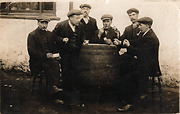 Donated by Mr Paul Colin Hodgson
Donated by Mr Paul Colin HodgsonEnjoying a game of dominoes. At least three of these men belonged to the crew of the Seaton Carew lifeboat Francis Whitbourn. This photographic postcard would date from c1910.
More detail » Alternative Lifeboat Colour Scheme
Alternative Lifeboat Colour Scheme
 Created by Mr. John Brooker
Donated by Mr. John Brooker
Created by Mr. John Brooker
Donated by Mr. John BrookerA prototype RNLI Arun-class Lifeboat entering Hartlepool Dock Channel, painted in ‘flourescent’ Yellow, as opposed to the normal lifeboat 'Dayglow Orange’. The boat was visiting Lifeboats Stations around the British Isles for crew members to appraise the new colour scheme. Following the survey, the new colour was rejected.
More detail » Appeal for funds - Lifeboat
Appeal for funds - Lifeboat
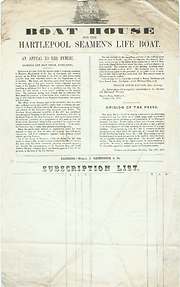 Donated by Hartlepool Library Service
Donated by Hartlepool Library ServiceAppeal for funds to build a lifeboat house in 1856.
More detail » Crew of the Princess Royal
Crew of the Princess Royal
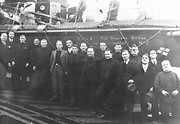 Created by unknown
Donated by Mr. John Brooker
Created by unknown
Donated by Mr. John BrookerAn undated photograph of the crew and helpers of the Princess Royal. The figure on the extreme right holding a flat hat in front of him is crewman 'Grandad Coulson'.
More detail » Crew of the lifeboat Ilminster (1)
Crew of the lifeboat Ilminster (1)
 Created by unknown
Donated by Mr. John Brooker
Created by unknown
Donated by Mr. John BrookerDated 1907
The crew of the lifeboat 'Ilminster', outside their boathouse on the North Sands, at the northern end of Marine Drive, Hartlepool Headland. The photograph is belived to have been taken in 1857 but more likely 1907.
More detail » Crew of the lifeboat Ilminster (2)
Crew of the lifeboat Ilminster (2)
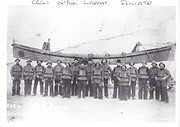 Created by unknown
Donated by Mr. John Brooker
Created by unknown
Donated by Mr. John BrookerThe crew of the lifeboat Ilminster standing in front of theiur boat, sometime in the 1850s.
More detail » Freedom of the Borough - 1986
Freedom of the Borough - 1986
 Created by unknown
Donated by Mr. John Brooker
Created by unknown
Donated by Mr. John BrookerDated 1986
Presentation of the Honorary Freedom of the Borough made to the crew members of the Hartlepool Lifeboats in 1986.
More detail » Hartlepool Inshore Lifeboat Station - 1975
Hartlepool Inshore Lifeboat Station - 1975
 Created by Mr. John Brooker
Donated by Mr. John Brooker
Created by Mr. John Brooker
Donated by Mr. John BrookerDated 1975
Hartlepool Inshore Lifeboat Station, Middleton, taken in the winter of 1975.
More detail » Hood, Henry
Hood, Henry
Henry Chilton Hood 1834-1913
Coxswain of Seaton Carew Lifeboats 1867-1898
(compiled by Maureen Anderson)
William Hood was born in Seaton Carew in about 1791 and had a large family including sons Robert b.1823, William b. c1826, Henry b.1834 and Charles b.c1836. William had become coxswain of the first Seaton lifeboat Tees when it was donated by Thomas Backhouse in 1823. During William’s time as coxswain on this first lifeboat he and his crew saved upwards of 188 lives. In January of 1851 he was presented with a bible and prayer book, a silver tobacco tin and money which had been collected by subscription from the people of Seaton Carew in approval of his conduct as Commander of the lifeboat. In October of 1851 he was awarded a Silver Medal by the Royal Society for the Preservation of Life from Shipwreck for going out to 32 wrecks and saving 120 lives. He died on 6 June 1855 aged 65. His eldest son Robert's position as coxswain of the lifeboat was confirmed on 1 October 1855 and held that position until 1867. In 1857 the Seaton lifeboat was taken over by the R.N.L.I. with a new boat Charlotte donated to Seaton. In 1863 Robert Hood was awarded the Silver Medal for his long and gallant service. The first Charlotte gave service until 1867 when another Charlotte replaced her. Then in 1873 came Job Hindley followed in 1888 by John Lawson and in 1908 Francis Whitbourn. The station was closed in 1922.
In 1851 Henry was aged 17 and a mariner’s apprentice. In 1857 he was married to Mary Allison Brownbridge and by 1861 they were living at 5 Pilot Street, Stranton, West Hartlepool. His occupation was listed as a Hartlepool pilot. In August of 1867 Robert Hood wished to retire as coxswain and an application was put forward to the Hartlepool Pilotage Board for Henry Hood to leave Hartlepool and move to Seaton Carew to become coxswain of their lifeboat. To do this he had to first obtain an ‘In and Out Branch’ as Pilot for the Tees which licence would have to be granted by Trinity House. This was duly granted in September 1867. By 1871 the family was living in Ashburn Street, Seaton Carew. In 1890 they were living at 15 Commercial Street, Middleton in the Parish of Stranton and in1891 they were living at Corner’s Garden and by 1901 Front Street.
Because of some mix-up with tug boats, on 11 March 1883 instead of running into Hartlepool Bay, the Norwegian schooner Atlas with her crew of five men went aground on the Longscar Rocks which jut out to sea from Seaton Carew. The signals of distress were seen and no time was lost in getting horses and men to equip the lifeboat. It was 9.45pm and dark when eight horses and 15 men managed to launch and push the life boat out to sea. Keeping to the lee of the rocks as much as possible the 13 crew of the lifeboat searched for the stricken schooner but could not see her because of the terrible sea running and sleet and hail forming a thick, freezing veil.
The lifeboat could not be taken nearer the rocks as she would haven smashed like a matchstick so a decision was taken by John Franklin and Henry Hood to do a search of the reef on foot as it was low tide. They groped their way along until on the north-east point nearest Hartlepool they saw the vessel with the seas breaking completely over her. They retraced their steps to the lifeboat and called for a heaving line which was thrown to them. At this point Matthew Franklin joined them in the water. Reaching a point near the ship they threw the heaving line which was caught by the captain but it also struck him below the knee. The mate had jumped overboard and he and the captain were barely conscious. Eventually step by step, hand over hand all five were taken aboard the lifeboat with Henry being dragged in last with severe leg cramps. They were back on shore by 12.30am and soon after the schooner had completely broken up.
John and Matthew Franklin and Henry Hood were all awarded Silver Medals for their bravery during this rescue. Henry also had the Albert Medal of the second class conferred upon him by Queen Victoria.
Henry eventually retired in August 1898 after 31 years as coxswain. He and his crew had been instrumental in saving 89 lives. On his retirement he was awarded the Silver Second Service Clasp Medal, a framed Certificate of Service from the R.N.L.I. and from the crew of the lifeboat and friends of Seaton Carew a silver watch, gold chain and £30.
In about 2010 the medals and silver watch were passed to the Hartlepool Museum by members of the Crawford family who had found them in their loft. It transpired that they were descendants of Henry and his family but had not known anything of the family history. Henry had left the items in his will to his niece Elizabeth Crawford, the daughter of his brother, John.
 Ilminster lifeboat postcard
Ilminster lifeboat postcard
 Created by Unknown
Donated by Maureen Anderson
Created by Unknown
Donated by Maureen AndersonPart of the Doyle Series collection
A postcard of the Ilminster on her carriage and with her crew.
More detail » Launch of a new Lifeboat 1878
Launch of a new Lifeboat 1878
 Created by J. Procter
Donated by Hartlepool Library Service
Created by J. Procter
Donated by Hartlepool Library ServiceLaunch of a new Lifeboat 1878
More detail » Letter from the Royal National Life-Boat Institution 1891
Letter from the Royal National Life-Boat Institution 1891
 Donated by Hartlepool Library Service
Donated by Hartlepool Library ServiceLetter from the Royal National Life-Boat Institution 1891 regarding the expenditure and funding of the service. It was sent to Clergy in Hartlepool asking them to start a Life-Boat Sunday in order to boost funds.
More detail » Lifeboat Cyclist (1)
Lifeboat Cyclist (1)
 Created by unknown
Donated by Susan Scott
Created by unknown
Donated by Susan ScottDated 1896
The Hartlepool Lifeboat 'Cyclist' photographed at at 'Lifeboat saturday' event at Coventry, on October 24th, 1896.
More detail » Lifeboat Launch
Lifeboat Launch
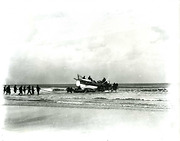 Donated by Hartlepool Library Service
Donated by Hartlepool Library ServiceLaunching a lifeboat, possibly Seaton Carew. Note the men with their trousers rolled up to their knees.
HHT+N 755
More detail » Lifeboat Princess Royal at sea
Lifeboat Princess Royal at sea
 Created by unknown
Donated by Mr. John Brooker
Created by unknown
Donated by Mr. John BrookerThe Lifeboat Princess Royal at sea off Hartlepool Headlan, date unknown.
More detail » Lifeboat Princess Royal returning to the Boathouse
Lifeboat Princess Royal returning to the Boathouse
 Created by unknown
Donated by Mr. John Brooker
Created by unknown
Donated by Mr. John BrookerThe Lifeboat Princess Royal returning to the Lifeboat House having been to 'Griggs' on the Fish Quay to re-fuel. The black building is the boathouse, while to the right are the Ferry steps, the Ferryman's small hut and the landing stage. The sheet-piled structure to the right is Withy's dam, used to protect Withy's Quay. The building right background, is Richardsons Westgarth's canteen.
More detail » Lifeboat Sermon, 1843
Lifeboat Sermon, 1843
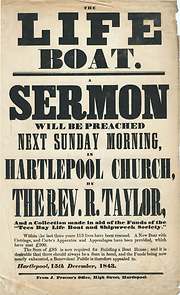 Created by J. Procter
Donated by Hartlepool Library Service
Created by J. Procter
Donated by Hartlepool Library ServiceLifeboat Sermon, 1843
More detail » Lifeboat Tees and Jessie Stevens
Lifeboat Tees and Jessie Stevens
 Created by Unknown
Donated by Bowes Museum, Barnard Castle, County Durham
Created by Unknown
Donated by Bowes Museum, Barnard Castle, County DurhamPart of the Part of the Pattison's Photographs collection
Dated 1849
From what was probably a drawing; The first Seaton lifeboat Tees goes to the aid of the Jessie Stevens near Teesmouth in 1849. She was in tow by the tug Reaper when the tow-rope broke and she went ashore on the North Gare. The crew of four were saved 'with great difficulty'. The Tees lifeboat was in service from 1824 to 1857 and was instrumental in saving at least 188 lives.
More detail » Lifeboat The Scout (1)
Lifeboat The Scout (1)
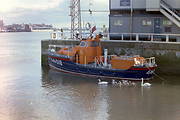 Created by Mr. John Brooker
Donated by Mr. John Brooker
Created by Mr. John Brooker
Donated by Mr. John BrookerA family of swans pays a visit to the Hartlepool Lifeboat The Scout tied up at the Central Dock Head, Hartlepool Docks. On the quayside is the Harbour Master's Office (top porta-cabin), and the Harbour Police Office.
More detail » Lifeboat The Scout (2)
Lifeboat The Scout (2)
 Created by Francis Elsdon
Donated by Hartlepool Museum Service
Created by Francis Elsdon
Donated by Hartlepool Museum ServicePart of the Elsdon Collection collection
Dated 1977
Hartlepool Lifeboat 'The Scout' entering Hartlepool.
More detail » Lifeboat The Scout (3)
Lifeboat The Scout (3)
 Created by Francis Elsdon
Donated by Hartlepool Museum Service
Created by Francis Elsdon
Donated by Hartlepool Museum ServicePart of the Elsdon Collection collection
Dated 1986
Hartlepool Lifeboat 'The Scout' entering Hartlepool. Lifeboat in Hartlepool from 1977 - 1997.
More detail » Lifeboat The Scout on exercise (1)
Lifeboat The Scout on exercise (1)
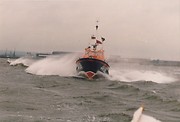 Created by unknown
Donated by Mr. John Brooker
Created by unknown
Donated by Mr. John BrookerDated 1989
The Hartlepool lifebout 'The Scout', on exercise in Hartlepool Bay in 1989.
More detail » Lifeboat The Scout on exercise (2)
Lifeboat The Scout on exercise (2)
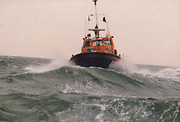 Created by unknown
Donated by Mr. John Brooker
Created by unknown
Donated by Mr. John BrookerDated 1989
The Hartlepool lifebout 'The Scout', on exercise in Hartlepool Bay in 1989.
More detail » Lifeboat The Scout on exercise (3)
Lifeboat The Scout on exercise (3)
 Created by unknown
Donated by Mr. John Brooker
Created by unknown
Donated by Mr. John BrookerDated 1989
The Hartlepool lifebout 'The Scout', on exercise in Hartlepool Bay in 1989.
More detail » Lifeboat at Middleton
Lifeboat at Middleton
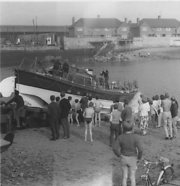 Created by Bill Boagey
Donated by Hartlepool Museum Service
Created by Bill Boagey
Donated by Hartlepool Museum ServicePart of the Bill Boagey collection
Dated 1963
A crowd gathered around the lifeboat on the slipway at Middleton. The ferry landing can be seen in the background.
More detail » Lifeboats on Raft Race Day - 1985
Lifeboats on Raft Race Day - 1985
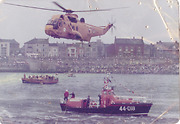 Created by unknown
Donated by Mr. John Brooker
Created by unknown
Donated by Mr. John BrookerDated 1985
The R.N.L.I.'S Raft Race Fund Raising Day, 1985. An RAF SEa King helicopter hovers above the Hartlepool lifeboat 'The Scout', off the Block Sands, Hartlepool Headland. The Teesmouth lifeboat 'Sarah & Jane Seasons' is in the background.
More detail » MV Beacon Point & Tug Stranton
MV Beacon Point & Tug Stranton
Part of the Elsdon Collection collection
Dated 1982
MV Beacon Point & Tug Stranton leaving Hartlepool. Lifeboat 'Scout' also in the picture.
More detail » Model of the Lifeboat Princess Royal (1)
Model of the Lifeboat Princess Royal (1)
 Created by unknown
Donated by Mr. John Brooker
Created by unknown
Donated by Mr. John BrookerThis model, recovered "from the top of a wardrobe" when John Richmond was tidying his Gran's bedroom, was carefully restored by Stockton model-maker Ken Duckers.
More detail » R.N.L.I. Elizabeth Newton
R.N.L.I. Elizabeth Newton
 Donated by Hartlepool Museum Service
Donated by Hartlepool Museum ServiceR.N.L.I. Elizabeth Newton leaving Hartlepool.
Elizabeth Newton had been built by J Samuel White of Cowes, Isle of Wight. Named in memory of the wife of Captain Richard Newton of Darlington, half of the £10,000 cost had been met by a legacy left by the late Mrs Newton.
Officially named by the Marchioness of Londonderry on August 23, 1924, the new motor lifeboat was stationed at Hartlepool until 1939, when she joined the RNLI reserve fleet, serving at several North-east stations until May 1953.
Read more at: http://www.hartlepoolmail.co.uk/news/hartlepool-lifeboat-starred-in-hollywood-blockbuster-1-7372693
Read more at: http://www.hartlepoolmail.co.uk/news/hartlepool-lifeboat-starred-in-hollywood-blockbuster-1-7372693
Read more at: http://www.hartlepoolmail.co.uk/news/hartlepool-lifeboat-starred-in-hollywood-blockbuster-1-7372693
Read more at: http://www.hartlepoolmail.co.uk/news/hartlepool-lifeboat-starred-in-hollywood-blockbuster-1-7372693
Read more at: http://www.hartlepoolmail.co.uk/news/hartlepool-lifeboat-starred-in-hollywood-blockbuster-1-7372693
Read more at: http://www.hartlepoolmail.co.uk/news/hartlepool-lifeboat-starred-in-hollywood-blockbuster-1-7372693
 R.N.L.I. Seaton motor lifeboat Bradford
R.N.L.I. Seaton motor lifeboat Bradford
 Donated by Maureen Anderson
Donated by Maureen AndersonDated 1907
In 1907 the motor lifeboat Bradford was stationed at the Snook. The lifeboatmen found it difficult to convert from rowing to motorised. She proved to be expensive as there were many breakdowns. Also a watchman had to be employed to look after the boat and her tackle. It was removed in 1909.
More detail » R.N.L.I. lifeboat Charlotte (1)
R.N.L.I. lifeboat Charlotte (1)
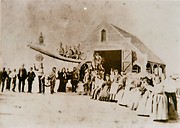 Created by unknown
Donated by Maureen Anderson
Created by unknown
Donated by Maureen AndersonDated 1857
The first Seaton lifeboat was the Tees donated by Thomas Backhouse in about 1824. In 1857 Seaton joined the RNLI and a new boat, Charlotte, was placed there. Here she is on her launching carriage outside the new boathouse built in October 1857. She was in service until 1867 when she was replaced by a boat of the same name which was in service until 1873. These two lifeboats were instrumental in saving 65 lives between them.
HHT&N 692
More detail » R.N.L.I. lifeboat Francis Whitbourn & crew - 1908
R.N.L.I. lifeboat Francis Whitbourn & crew - 1908
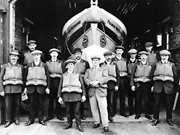 Donated by Mr. Paul Colin Hodgson
Donated by Mr. Paul Colin HodgsonDated 1906
The crew of the Seaton Carew Lifeboat Francis Whitbourn gathered at the Lifeboat House in 1908. The Station closed in 1922.
HHT&N 695
More detail » R.N.L.I. lifeboat Francis Whitbourn (1)
R.N.L.I. lifeboat Francis Whitbourn (1)
 Donated by Maureen Anderson
Donated by Maureen AndersonDated 1908
The RNLI Seaton lifeboat Francis Whitbourn being hauled towards the beach for a practice launch in 1908. She was donated by Robert Lodge and had cost £802. She was in use from January 1908 until April 1922 when the lifeboat station at Seaton ceased to be. In this time she was instrumental in saving 21 lives.
HHT&N 547
More detail » R.N.L.I. lifeboat Francis Whitbourn (3)
R.N.L.I. lifeboat Francis Whitbourn (3)
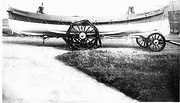 Donated by Mr R Williams
Donated by Mr R WilliamsPart of the Hartlepool Library collection
Dated 1908
 R.N.L.I. lifeboat John Lawson (1)
R.N.L.I. lifeboat John Lawson (1)
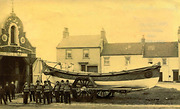 Donated by Maureen Anderson
Donated by Maureen AndersonDated 1888
Henry Hood and seven members of the crew with the RNLI Seaton lifeboat John Lawson on her launching carriage outside the lifeboat house at the southern end of Seaton Carew.
More detail » R.N.L.I. lifeboat John Lawson (2)
R.N.L.I. lifeboat John Lawson (2)
 Created by James Whitehead Pattison
Donated by Bowes Museum, Barnard Castle, County Durham
Created by James Whitehead Pattison
Donated by Bowes Museum, Barnard Castle, County DurhamPart of the Pattison's Photographs collection
Dated 1888
The naming ceremony of the lifeboat John Lawson on the Green in May 1888. The christening was carried out by Margaret Lawson, daughter of the vicar after whom the boat was named, and James W Pattison invoked a blessing.
More detail » R.N.L.I. lifeboat John Lawson (3)
R.N.L.I. lifeboat John Lawson (3)
 Created by James Whitehead Pattison
Donated by Bowes Museum, Barnard Castle, County Durham
Created by James Whitehead Pattison
Donated by Bowes Museum, Barnard Castle, County DurhamPart of the Pattison's Photographs collection
Dated 1888
The John Lawson on her carriage at her naming ceremony on The Green, Seaton Carew in May 1888. Henry Hood, coxswain, has his arm on the nearside of the boat & next to him is Robert Robinson. All the crew are wearing their cork life-jackets.
More detail » R.N.L.I. lifeboat John Lawson (4)
R.N.L.I. lifeboat John Lawson (4)
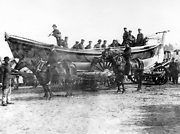 Created by unknown
Donated by Hartlepool Library Service
Created by unknown
Donated by Hartlepool Library ServiceR.N.L.I. Lifeboat John Lawson being towed to the sea at Seaton Carew by horses.
HHT&N 694
More detail » R.N.L.I. lifeboat John Lawson and crew
R.N.L.I. lifeboat John Lawson and crew
 Donated by Mr Paul Colin Hodgson
Donated by Mr Paul Colin HodgsonThis photo was probably taken on the day of the naming of the John Lawson in 1888. Along the front row the first man proudly sporting medals is John Henry Franklin then Henry Hood and next to him is Matthew Franklin. The medals were received for their services to the Atlas in 1883. Second from the end of the row, wearing a cork life jacket, is George Hodgson.
More detail » R.N.L.I. lifeboat John Lawson and the Granite
R.N.L.I. lifeboat John Lawson and the Granite
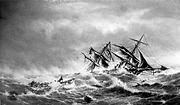 Donated by Maureen Anderson
Donated by Maureen AndersonOn 12th December 1888 the John Lawson lifeboat went on its first mission to the West Hartlepool owned ship Granite. Sadly all eight of the crew of the Granite perished and the ship was wrecked. The crew of the lifeboat consisted of; Henry, Robert and William Hood, Robert Robinson, J Kendall, Thomas Blekinsop, F Kitson, William Proctor, Matthew Franklin, W Harrison and R Burton.
More detail » Re-housing the lifeboat Ilminster
Re-housing the lifeboat Ilminster
 Created by unknown
Donated by Mr. John Brooker
Created by unknown
Donated by Mr. John BrookerPreparing to re-house the lifeboat 'Ilminster' after a launch. Date unknown.
More detail » Tenders wanted for a Life Boat House, 1851
Tenders wanted for a Life Boat House, 1851
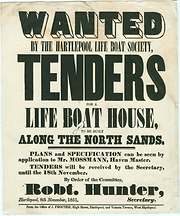 Created by J. Procter
Donated by Hartlepool Library Service
Created by J. Procter
Donated by Hartlepool Library ServiceTenders wanted for a Life Boat House, 1851.
More detail »




